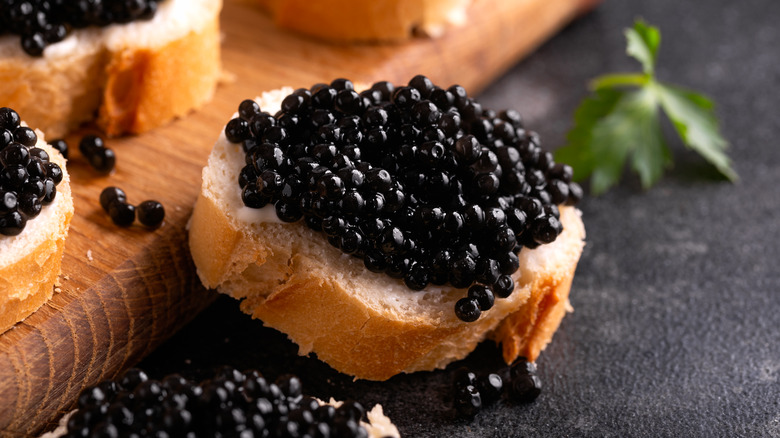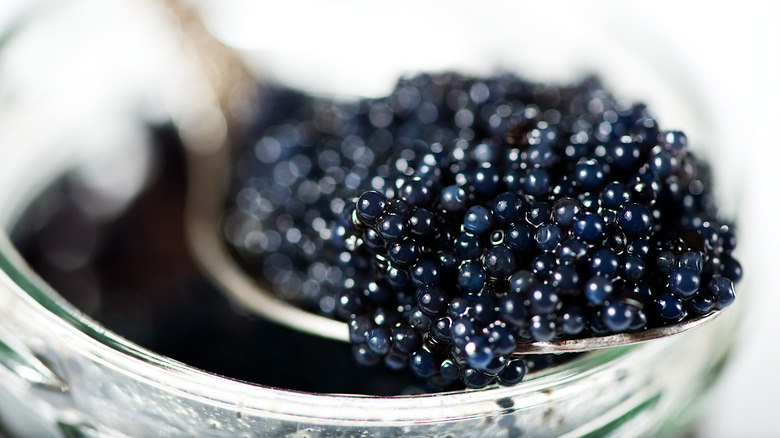The Pressed Caviar Fad That Mysteriously Disappeared
No food is more closely associated with the finer things in life than caviar. Surprisingly, this sought-after delicacy is a relatively simple food. As Encyclopedia Britannica details, caviar is nothing more than salt-cured sturgeon eggs. But, as connoisseurs know well, this simplicity is at the heart of caviar's appeal: It allows the quality of the precious eggs to shine through. These eggs are so memorably flavorful — encompassing nuttiness, sweetness, and brininess — that caviar's popularity and elite status have endured over the course of many decades.
But not all caviar is created equal. Beluga caviar is far larger than sevruga caviar. Different varieties of sturgeon produce roe with distinct textures. The best caviar contains no more than 3.5% salt, while lesser grades ratchet that percentage up to 8, according to The New York Times. Caviar is also distinguished by color: The lighter its shade, the more it costs. While it might seem like an unchanging symbol of opulence, caviar is, in fact, anything but static. The fine food's production methods, recipes, and cultural status have fluctuated dramatically over the course of centuries. In fact, the 1950s gave rise to a caviar fad that lit up elite kitchens all over the globe — then mysteriously vanished.
Pressed caviar's heyday
According to internationally celebrated chef Jacques Pépin, pressed caviar was once all the rage. In a 2008 article in Food & Wine (via the Michelin Guide), the culinary icon remembered using the unique ingredient while working at Paris' Le Pavilion restaurant in the 1950s. What is pressed caviar, exactly?
As Town & Country details, it's pretty much exactly what it sounds like: caviar compressed into a solid form. Known as payusnaya in Russian, it's made from a variety of broken surgeon eggs, which are unsuitable for use in conventional caviar. Some pressed caviars, like the one developed by Pépin with the California Caviar Company, are a jammy paste, sold in jars. Others, like the Lingotto variety sold by Calvisius Caviar, are firm enough to resemble chocolate bars, and can be shaved over a dish. While even committed foodies might never have heard of it, pressed caviar has a long and impressive history: Aristotle Onassis was a devotee, preferring it to traditional caviar.
"Payusnaya was common when I was a young man in Paris, so I am amazed when chefs now don't know what it is," Pépin mused to 5280. This 1950s peak of popularity stretched across the globe: Big Apple establishment Janssen's Restaturant offered a 4-ounce jar of Romanoff pressed caviar for $4.50, back in 1959. Aficionados everywhere delighted in its unique texture and signature taste ... until it disappeared from menus entirely.
Caviar's fluctuating fortunes
Why did pressed caviar disappear after the 1950s? It's unclear — but it's certainly not the only time caviar's availability has fluctuated. As Encyclopedia Britannica notes, this high-priced food wasn't always a luxury — in fact, until the late 19th century, it was downright affordable.
Dwindling sturgeon rates curtailed production, setting caviar on the path to its current rarefied status. Caviar has also been impacted by geopolitical realities: As Inga Saffron details in "Caviar: The Strange History and Uncertain Future of the World's Most Coveted Delicacy," the end of the Cold War unleashed an explosion of caviar. Suddenly, multiple American cities boasted entire stores dedicated to the spectacular stuff, travelers could pick it up in airport terminals, and everyday people with a bit of extra money in their pocket could splurge on it for their holiday spreads. This bubble eventually burst — once again, sturgeon supplies ran dry — but it didn't destroy caviar's mystique. If anything, it burnished it.
What does the future hold for pressed caviar specifically? The possibilities seem endless. Jacques Pépin is no longer alone in appreciating the unique foodstuff: As the Michelin Guide reveals, it's made its way to Hong Kong, where chef Olivier Elzer tops buttery razor clams with a pressed caviar sauce. Elzer might be the first chef in Hong Kong to use the ingredient, but he seems unlikely to be the last. Diners just can't get enough of caviar, no matter the era.


